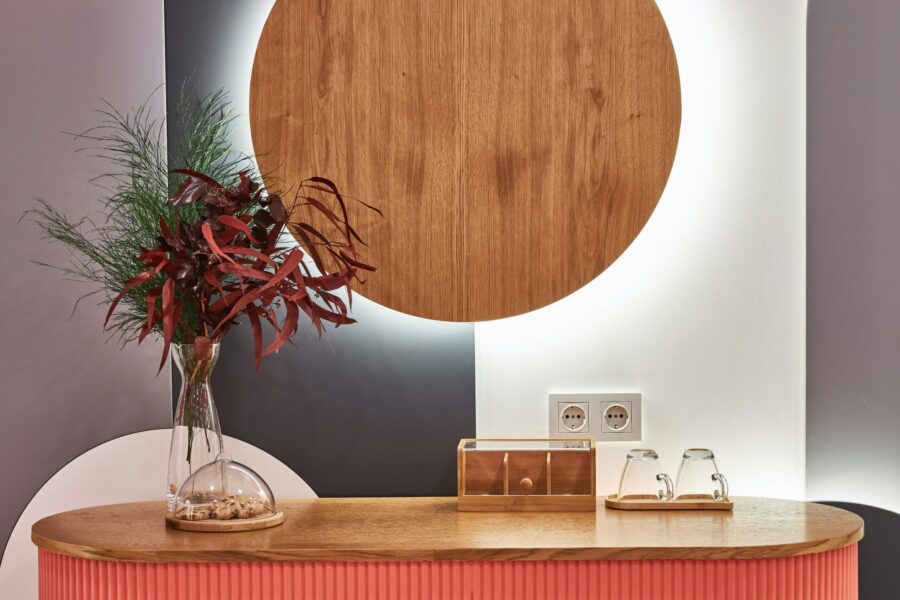Gone are the days of workplace fit-outs being designed purely for utility, with the focus now on creating environments that are human-centric and prioritise staff wellbeing. Employee wellness is a crucial factor in driving business success.
Here I will discuss the profound shift being observed when it comes to the interior makeup of contemporary office spaces, with employers focusing on design elements that once, would have been nothing more than an afterthought.
Interconnectedness between design and human behaviour has resulted in the adoption of human-centric interior design, offering a balance between sociability and solitude that is a crucial wellbeing consideration born from the rise of hybrid working and our appreciation of different work settings contributing to our productivity.
The importance of wellbeing in the workplace
Historic trends have showcased a ‘job for life’ mentality in the UK’s workforce, but as the employment landscape continually adapts and changes it’s more common to see younger generations job hopping, with a focus on fulfilment in mind. For businesses to reduce staff turnover and retain employees, positive culture and support is more crucial than ever.
Space can influence culture. It may seem surprising that four walls can command such collaboration, but it is what is created within the four walls that really drives the environment. Through human-centric design elements, the space can foster an environment that is both personal but also personified for the best of the business and its staff.
A key human characteristic for wellbeing and belonging is needing to feel listened to and valued by those around us, and office environments can hugely impact this based on how they prompt conversation and learning opportunities. This feeling of being valued can be the deciding factor for many in the working world on whether to twist or stick with a company, with the past few years alone showcasing how the workforce isn’t focused on ‘living to work’ but ‘working to live’.
Where has the shift come from?
We all know that hybrid working has unveiled a new working world, with businesses understanding the need to adapt and offer the comfortability, freedom and productivity staff have found in the comfort of their own homes.
Across the UK, flexible working requests have increased, with office occupation at 35 to 40% compared to pre-2020 levels of 60 to 80%. Coupled with the rise of businesses reviewing office locations and leases, the landscape is at a beneficial point for reviewing how it is best to work in this new age.
Workplace analysis is vital to creating longevity through an office environment and supporting the solidification of presence. For this to be done effectively, it’s important to listen more than anything – not just to the industry and people external to the business, but those within it. Success comes from understanding employees and what they would like to see – making that the focus above what they dislike about the office environment. This incorporates all manner of focuses, relating to how they operate through to their own personal growth objectives, which can be supported with a change to the environment.
Flexibility comes to fruition in both what employees and employers can achieve through an optimal working environment – and the idea that not one size fits all is prevalent in both aspects. Hybrid working opened the door for employees to increase flexibility in their working lives, and the idea of being stuck in front of a screen in a boxed cubicle is now old-fashioned.
Workplace analysis lays the foundations to create a business and its culture that is completely achievable and gives scope to venture further than the steadfast office designs of the past.
Human-centric design elements
Creating a fusion of environments suited for both increased wellbeing focus on staff and for optimal achievement of overall business aims is no easy task. It is however completely achievable through the right design elements, focusing on the innovation and collaboration needed for businesses that have seen a shift in the way of working.
Utilising an open plan layout can encourage cross-team interaction, further enhanced by hotdesking and removing barriers like cellular offices. This works to make the act of speaking and working with others incredibly easy, fostering a team dynamic with the consensus of one for all, not all for one.
Multiple office levels are almost standard, especially in growing city centres and towns where multi-storey buildings are the norm. The question that is created when an office splits across more than one level is how to draw people together through this space. Architectural interventions like mezzanine floors and centralised connecting staircases can encourage interaction and engagement throughout.
Done right, the human-centric design of multiple levels will create fluidity. So-called ‘collision spaces’ support a coherent point of human nature – that we are social animals. The creation of seating areas for example, at connection points between floors or open office touch-down spaces, will see the natural gravitation of employees, away from desks into more central spaces for socialisation. In fact, there is a clear demand being seen for leased office spaces which include these ‘collision spaces’.
Physical and mental wellbeing
We all know that movement is good for people and staying static is not. Even so, some employees believe that their employer frowns on time away from the desk as time spent not working. Around one third of employees in the UK report experiencing Musculo-skeletal issues and many, operating in more traditional workplace settings, choose to remain at their desk for breaks and lunch, and to email colleagues rather than going to see them. Offices are not about being chained to your desk, especially as the positive impact on both health and productivity is well documented. So, spaces that prioritise movement rather than staying in one place, should always be the optimal route forward.
This links to the notion of creating a space that works for everyone – making sure that the same freedom of movement is there through appropriate accessibility measures, allowing all staff and visitors to access spaces easily and equally.
An area that can be trickier to navigate is making spaces work for a range of working styles or neurodivergences, where factors and impacts are very personal. Some find it difficult to work within noisier environments, while others thrive. So, different types of space within the overall makeup should strive to support all needs, providing safe havens alongside the bigger collaborative spaces – and whether that’s to support neurodiverse needs or simply quiet space to concentrate on harder tasks, productivity flourishes in a varied environment.
When asking employees to prioritise their needs for a new office environment, we find that natural light, good heating and controllable ventilation feature at the top of the list. And so, window seats are at a premium and of course, people favour a connection to the outside world. Too many office environments are devoid of good natural light and connection with nature, favouring a much blanker canvas that can in turn result in raised cortisol levels.
Biophilic design has come into its stride with businesses pushing for this relationship with the outside living world. Increased natural light and utilisation of live plants in office spaces come hand in hand, with plants offering a connection with the living world that can make us feel calmer. Returning to the demand for leased office space, it’s true to say that this connectivity is high on the wish-list.
As we appreciate the benefits of and encourage office-based working, in conjunction with remote working, there is still work to be done within workplaces to truly offer everything needed for a business to thrive in this post-pandemic world. Without the necessary time and effort given to this, there is the possibility of falling victim to the volatile nature of the employment market, with the younger generations especially moving at a drop of a hat and more mature generations choosing to work from the comfort of their own home, if the office environment does not have a positive pull.

Ruth Evans
Ruth Evans is an associate and workplace analysis consultant at award-winning architectural practice, CPMG. With more than 20 years of experience in the sector, Ruth supports the practice’s workplace analysis offering which looks to support businesses with workplace design with employee wellbeing in mind.


